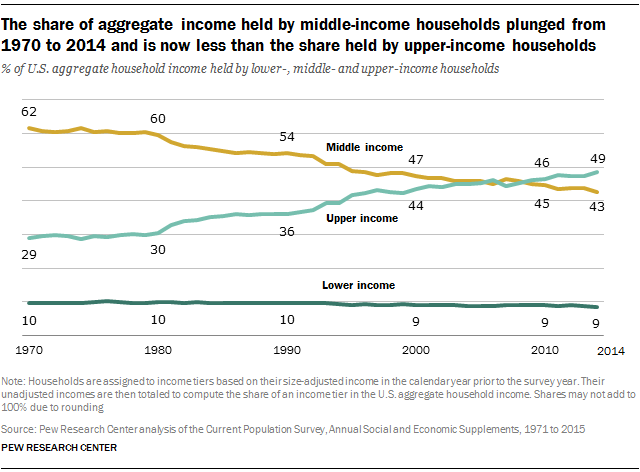A State-by-State Analysis Of Middle Class Incomes In The US

Table of Contents
Defining the Middle Class and Methodology
Defining the "middle class" is inherently complex and often debated. For this analysis, we'll define the middle class using the median household income, specifically focusing on the income range encompassing the 25th to 75th percentile of the national income distribution. It's important to acknowledge the limitations of this definition; it doesn't account for variations in cost of living across states, wealth accumulation, or access to resources. Nevertheless, this metric provides a useful benchmark for comparing middle-class incomes across different states. The purpose of this article is to present a comprehensive analysis of middle class incomes across the US, providing a state-by-state comparison and exploring the underlying factors driving regional disparities. We will examine the top and bottom ten states, and discuss broader policy implications.
Methodology and Data Sources
The data for this analysis primarily comes from the U.S. Census Bureau's American Community Survey (ACS) and the Bureau of Economic Analysis (BEA). The ACS provides detailed income data at the state level, allowing for a granular examination of income distribution. The BEA offers supplementary economic data, which helps contextualize income figures within broader economic trends.
Our methodology involves calculating the median household income for each state and then identifying the 25th to 75th percentile range to represent the middle class for that state. This allows for a comparison across states, though it's crucial to acknowledge limitations. The cost of living varies significantly across states; a household with a given income in a high cost-of-living area may have a lower standard of living than a household with the same income in a lower cost-of-living area.
- Data Sources:
*
*
We utilized data from the most recent available year to ensure the analysis reflects the current economic climate.
Regional Variations in Middle Class Incomes
Significant regional disparities exist in middle class incomes across the United States. By dividing the country into four regions – Northeast, South, Midwest, and West – we can observe substantial differences:
-
Northeast: Generally boasts higher average middle class incomes, driven by strong economies in major metropolitan areas and a higher concentration of high-paying jobs in finance, technology, and education. However, the high cost of living in many Northeastern states offsets some of this advantage.
-
South: Exhibits a wider range of middle class incomes, with some states showing higher than average incomes due to growing tech sectors and lower costs of living, while others lag behind due to lower wages and limited economic opportunities in certain areas.
-
Midwest: Characterized by a more moderate distribution of middle class incomes, with some states benefiting from a diversified economy, while others face economic challenges related to industrial decline and manufacturing job losses.
-
West: Similar to the Northeast, some Western states show high middle class incomes due to thriving tech industries and high-paying jobs in California and other areas, but this is often offset by exceptionally high cost of living in many Western states.
State-Specific Analysis of Middle Class Incomes (Top 10 Highest & Lowest)
The following tables showcase the top and bottom ten states based on middle-class income. It's important to remember that these figures are a snapshot in time and do not encompass the nuances of cost of living.
(Top 10 Highest – Data would be inserted here)
(Top 10 Lowest – Data would be inserted here)
Impact of Factors on Middle Class Incomes
Several key factors significantly influence middle class incomes:
Education
Higher levels of education are strongly correlated with higher incomes. Individuals with advanced degrees (Master's, Doctorate) generally earn significantly more than those with only a high school diploma. Access to quality education, therefore, plays a crucial role in upward mobility.
- Key Finding: States with higher rates of college graduates tend to have higher average middle class incomes.
Employment
The type of industry and employment sector significantly impacts income levels. States with strong technology, finance, or healthcare sectors often have higher average middle class incomes. Conversely, states heavily reliant on low-wage industries face lower average incomes.
- Key Finding: Diversified economies tend to lead to a more robust and balanced middle class.
Cost of Living
The cost of housing, transportation, healthcare, and other essential goods and services greatly influences the purchasing power of middle-class incomes. A high cost of living can significantly diminish the real value of an income, even if the nominal income is relatively high.
- Key Finding: States with high costs of living often require higher incomes to maintain a comparable standard of living.
Taxation
State and local taxes can impact disposable income for middle-class households. High tax burdens can reduce the amount of money available for spending and saving.
- Key Finding: Tax policies significantly affect the financial well-being of middle-class families.
Future Trends and Policy Implications
Projecting future trends in middle class incomes requires careful consideration of various economic factors. Continued automation, global competition, and income inequality could pose challenges to the growth of the middle class.
Addressing these challenges necessitates proactive policy interventions. These include investments in education and workforce development, policies promoting fair wages and worker protections, affordable healthcare and housing initiatives, and targeted tax policies to alleviate the burden on middle-class families. The ongoing debate surrounding a living wage and expanding social safety nets are key considerations for the future of middle class incomes in the US.
- Key Policy Recommendations: Invest in education, promote fair wages, expand access to affordable healthcare and housing.
Conclusion: Understanding Middle Class Incomes Across the US
This state-by-state analysis reveals significant disparities in middle class incomes across the United States. Regional variations are influenced by a complex interplay of factors, including education levels, industry composition, cost of living, and tax policies. Understanding these disparities is crucial for policymakers seeking to design effective economic policies and for individuals seeking to navigate the challenges of a rapidly evolving economic landscape. We encourage you to further explore the data provided by the Census Bureau and the Bureau of Economic Analysis to delve deeper into your state's economic conditions and consider the broader implications of middle class income trends for the future of the American economy. Understanding middle class income data is vital for building a more equitable and prosperous future for all Americans.

Featured Posts
-
 Revelatii In Dosarele X Posibilitatea Unei Noi Anchete
Apr 30, 2025
Revelatii In Dosarele X Posibilitatea Unei Noi Anchete
Apr 30, 2025 -
 Luto En El Futbol Argentino Fallece Joven Referente De Afa
Apr 30, 2025
Luto En El Futbol Argentino Fallece Joven Referente De Afa
Apr 30, 2025 -
 Channing Tatum And Inka Williams Sydney Trip Concludes
Apr 30, 2025
Channing Tatum And Inka Williams Sydney Trip Concludes
Apr 30, 2025 -
 Trump Supporter Ray Epps Defamation Lawsuit Against Fox News Details Of The Jan 6 Case
Apr 30, 2025
Trump Supporter Ray Epps Defamation Lawsuit Against Fox News Details Of The Jan 6 Case
Apr 30, 2025 -
 Private Credit Jobs 5 Essential Dos And Don Ts For Success
Apr 30, 2025
Private Credit Jobs 5 Essential Dos And Don Ts For Success
Apr 30, 2025
